- Home
- Northamptonshire walks
- Barnwell Country Park
- Great Crested Grebe
Great Crested Grebe Breeding Season
Have you ever been so entranced by a creature that you find yourself holding your breath, afraid even the slightest movement might break the spell?
That's how I felt the first time I witnessed the elaborate courtship dance of the Great Crested Grebe.
With intricate head-shaking, neck-arching and synchronised dipping motions, these striking waterbirds turned the glassy surface of the lake into their own private stage.
In that moment, I was determined to do more than just admire their beauty from afar.
I wanted to truly understand their world by immersing myself in the full cycle of their lives - from the first moments of courtship to the heart-melting moments of newborn chicks riding safely on their parents' backs.
Over the following months at my local nature reserve, I would become intimately acquainted with the Grebes' remarkable breeding behaviours through patient observation and the click of my camera shutter.
I would love to share the experience with you.
Setting the Scene

It was early spring at Barnwell Country Park in Northamptonshire, England when I first set out to document the breeding cycle of the Great Crested Grebe.
The park's tranquil lakes, fringed by reeds and willow trees, had been a haven for these elegant waterbirds for generations.
FUN FACT: Did You Know that Great Crested Grebes are said to be closely related to flamingos?
As I approached the water's edge, the morning mist still clung to the surface, creating an ethereal backdrop for the grebes' courtship displays.
It was a sight that carried profound historical significance - in the 19th century, the species had teetered on the brink of extinction in the UK due to the senseless plundering of their striking head plumes to adorn fashionable ladies' hats.
Down to just 42 nesting pairs, the grebes' plight catalyzed the formation of the Royal Society for the Protection of Birds and pioneering conservation efforts.
Now, their remarkable comeback allowed me to bear witness to behaviours once in jeopardy of being lost forever.
The Elaborate Courtship Display
The first few weeks of observation were filled with breathtaking courtship rituals.
I watched, entranced, as the pair of grebes would rise up vertically in the water, shaking their elaborate chestnut head plumes, mirroring each other's movements.
At times, they would run across the glassy lake surface in a frenzy of splashing water, chasing and presenting each other with trailing strands of pond weed.
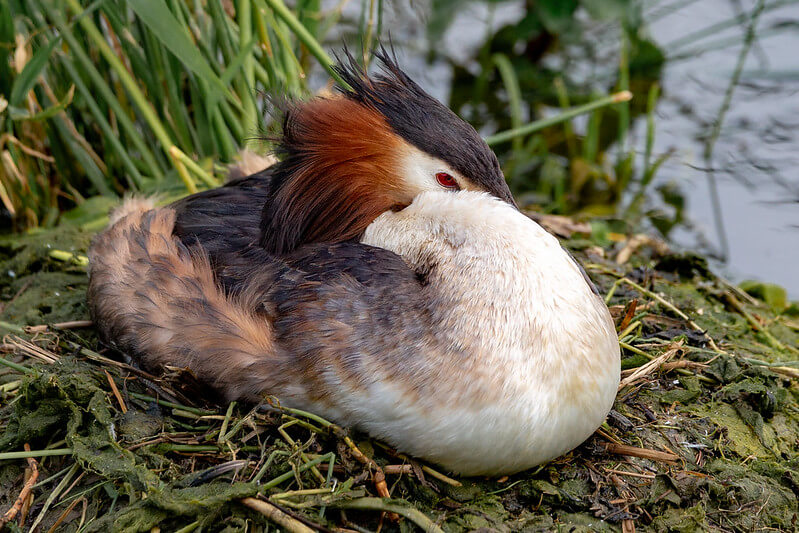
I took this bird's picture from a hide at Rutland Water. The hide let me get up close, giving a much better view of the beautiful head and neck decorations.
The Great Crested Grebe nest
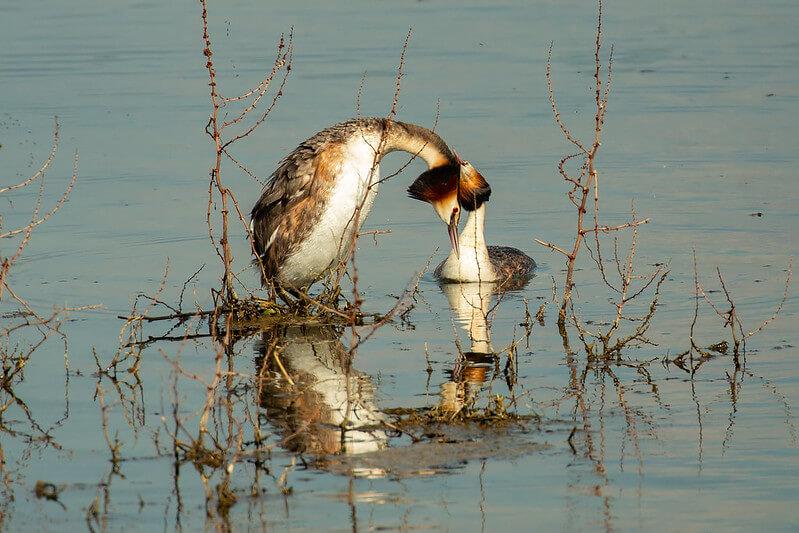
As the courtship period gave way to nesting, I was granted a window into the grebes' exceptional parenting abilities. With painstaking care, the pair constructed a floating nest from twigs and water weeds anchored to submerged vegetation.
One bird would meticulously add new materials each day while the other stood guard, fiercely deterring any rival birds who dared venture too close.
I marvelled at their unwavering attentiveness as the pair took turns incubating the larger than normal clutch of five creamy coloured eggs, constantly rearranging and tenderly covering them to retain warmth.
It was like a perfectly choreographed routine, and I couldn't help but feel a sense of admiration for their dedication.
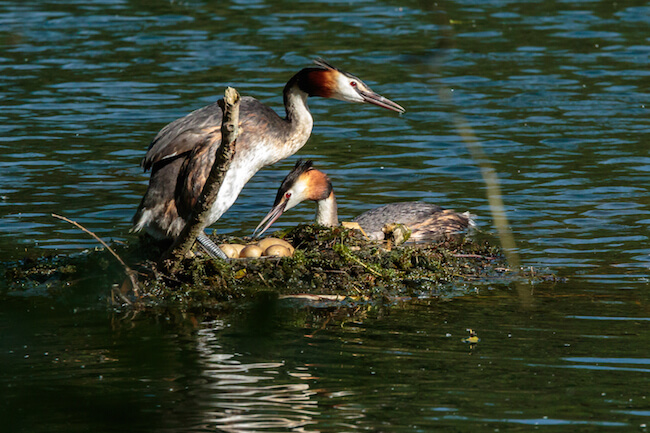 (Cropped) Grebes on nest with eggs
(Cropped) Grebes on nest with eggs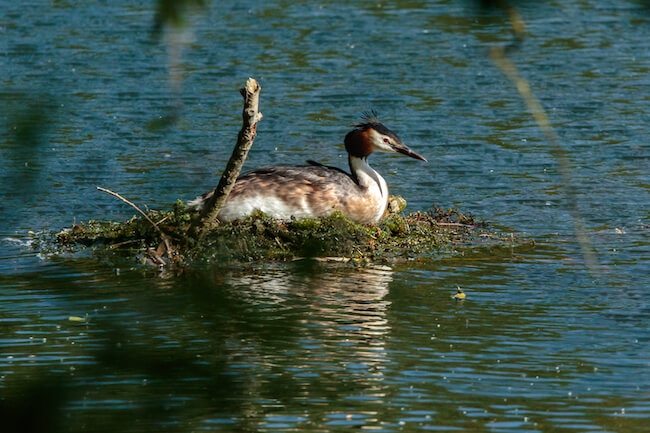 Incubating the eggs
Incubating the eggsThe Eggs Have Hatched!
Then, after nearly a month of devoted nest-tending, the first fuzzy chicks began to emerge.
Within hours of hatching, the striped youngsters were climbing onto their parents' backs, sheltered from wind and predators. It was an instinctive behaviour passed down through generations - a safe mobile crèche that allowed the grebes to forage and care for their broods.
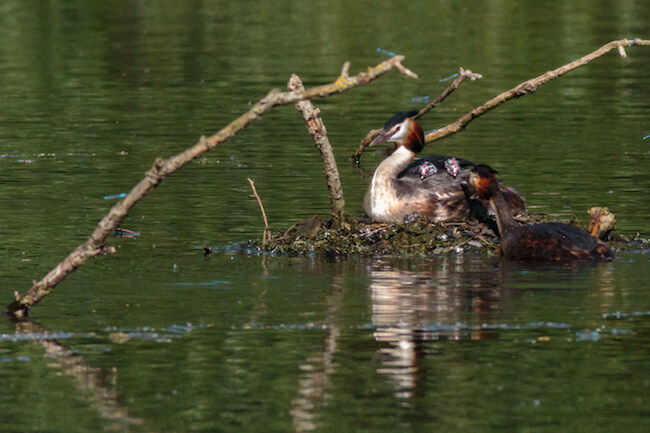 Three tiny babies on mother's back
Three tiny babies on mother's backI spent hours capturing the heart-melting scenes through my lens - the tiny chicks peering out from their parents' feathers.
Yet as enchanting as these images were, they represented just a fleeting moment. For in the turbulent life of a waterbird, there were perils ahead.
The Hazardous First Weeks
Despite their parents' attentive care, the first few weeks were a hazardous time for the great crested grebe chicks. The slightest miscalculation could spell disaster as the vulnerable youngsters faced an onslaught of threats.
I held my breath as the family navigated the dangers, avoiding ambush from cunning pike lurking in the shallows. More than once, I witnessed the grebes rapidly bundling their chicks onto their backs at the first sign of a marauding heron taking flight nearby.
Luckily there was no sign of the resident otters!
Feeding The Family
Both parent birds were hard at work, constantly fishing and feeding their hungry babies. For hours, I stood there, mesmerised and I was fortunate enough to witness several successful catches.
Great crested grebes eat mainly fish but will also feed on aquatic invertebrates and on one occasion I saw one with a frog in its bill.
I also observed the parent birds feeding their own feathers to the babies. After researching this, it seems the feathers help aid the chicks digestion.
The following photo is an extreme crop (slightly grainy because of the high ISO needed) of a precious moment - one of the chicks being fed a meal. Although tiny, those little bills could swallow surprisingly large fish.
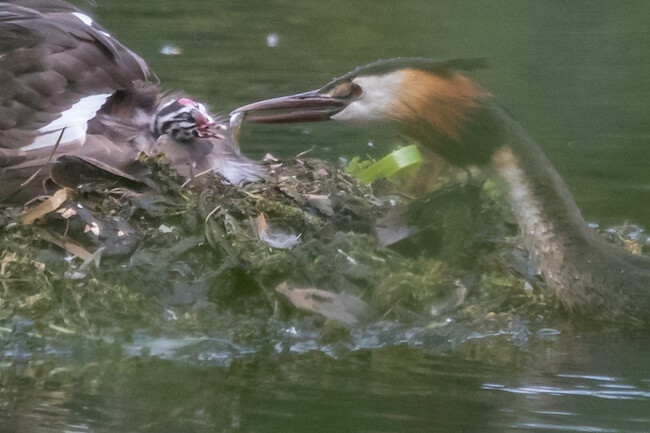
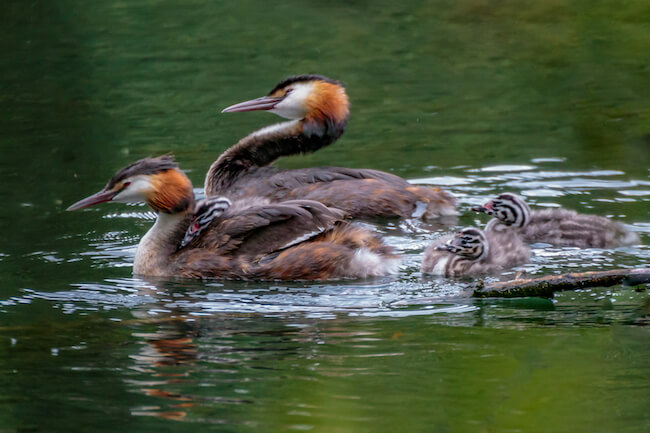 Young grebe family
Young grebe familyDay by day, I marvelled at the rapid growth of the fuzzy chicks. Within a week, their downy feathers began giving way to waterproof plumage. Soon, they were venturing off their parents' backs to test their swimming abilities, trailing behind the adults who kept a watchful eye.
With their new-found skills, the young grebes faced a new set of challenges.
I watched in awe as the family group cooperated to fend off territorial clashes with other grebes vying for prime feeding territory. The parents put on impressive displays of aggression, rearing up and thrashing their wings while the chicks took cover.
A Tragic Moment
But for all the grebes' perseverance, there were inevitable losses.
One overcast morning, I arrived at the lake to find the pair attending to just two chicks instead of three. The missing youngster was nowhere to be seen.
I can only speculate as to its fate - whether taken by a predator, or simply succumbing to exposure in the night. Nature, I was reminded, can be unforgivingly harsh.
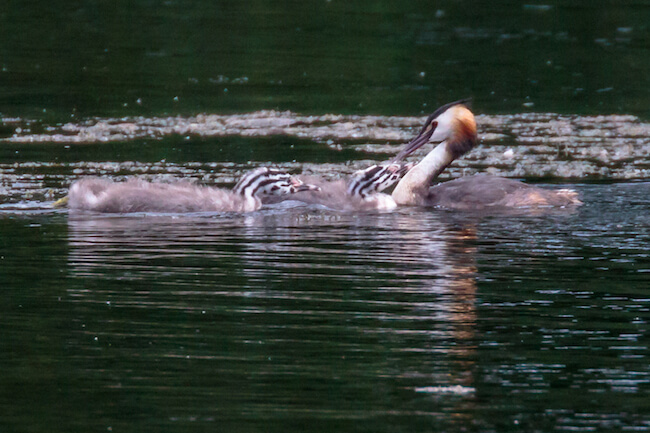 Two baby grebes
Two baby grebesGrowing Up
The adult birds left the remaining chicks alone as they went fishing, using their sharp, pink bills like daggers to catch their prey.
The babies still tried to catch a ride, even though they were growing larger!
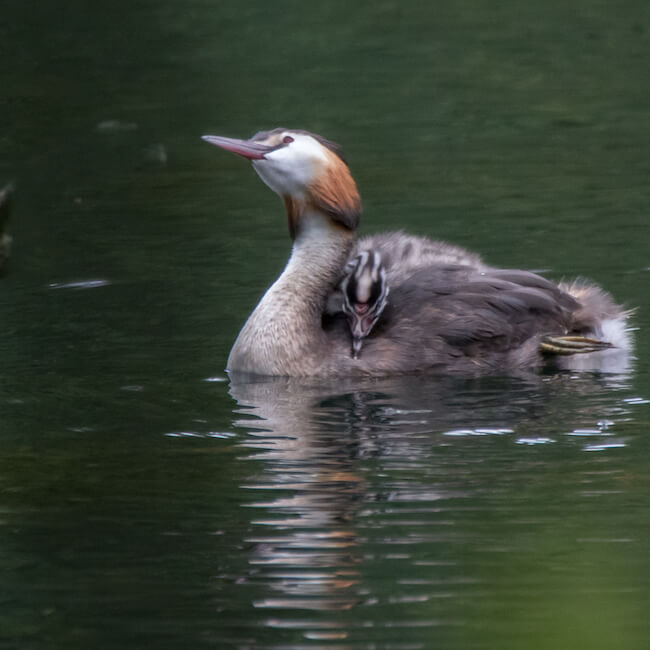 Hitching a ride
Hitching a rideAs the chicks continued to grow, their antics became more entertaining by the day.
I'll never forget the hilarious sight of those chubby babies begging for food with their piping calls, their little bottoms up in the air and legs paddling furiously. Do you see how far back on their bodies those legs are? This makes them very clumsy looking when on land.
On other days, the whole family could be seen gliding serenely across the glassy surface, the two remaining chicks nestled snugly amidst their parents' buoyant feathers or swimming along behind. It was a heart-warming portrait of togetherness in the face of adversity.
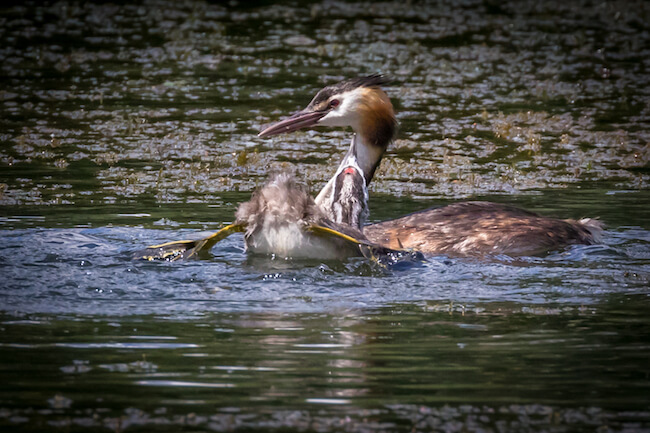 Young grebe demanding food
Young grebe demanding foodTime to Say Goodbye
As summer's warmth enveloped the reserve, the two youngsters gradually lost the stripes from their bodies.
Soon, they would disperse to stake out their own territories, armed with the finely-honed survival skills imparted over the preceding months.
I knew my time observing the grebe family was nearing its end.
Though our paths would diverge, I knew the memories of their remarkable journey would stay with me forever - a poignant reminder of nature's struggles, sacrifices, and humble triumphs.
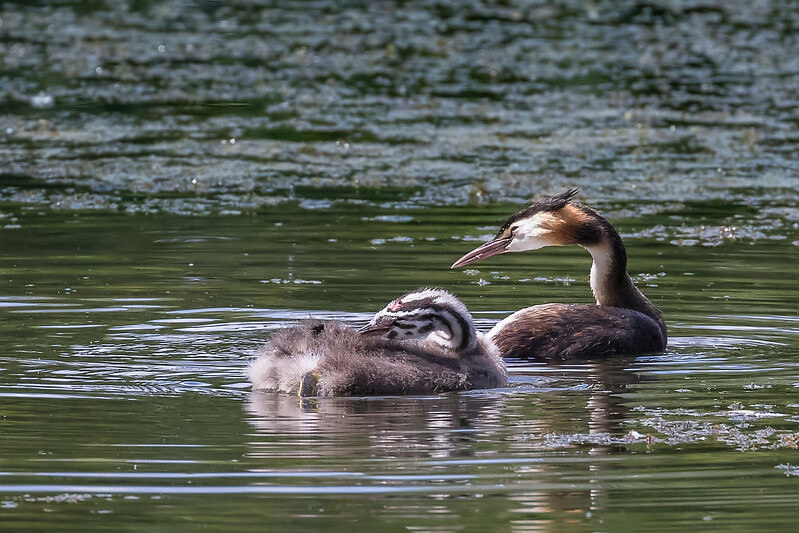
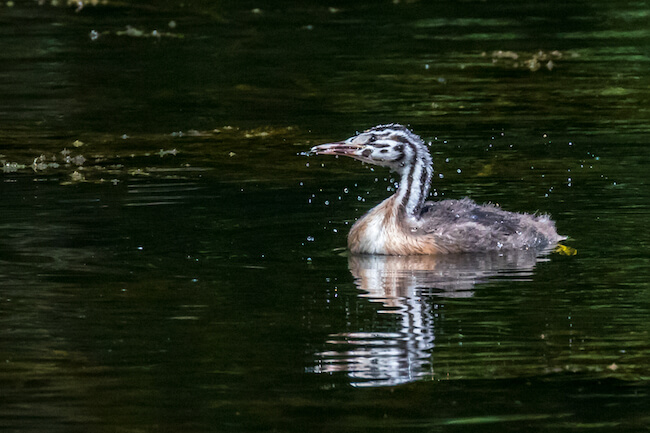 Baby grebe shaking off water droplets
Baby grebe shaking off water dropletsOne morning, I arrived at the lake to find the family gone, the placid water lying empty save for a few stray feathers drifting on the surface. The grebes had set off on their next journey, their lives forever intertwined with the ebb and flow of the seasons.
As I packed up my camera gear, I felt an immense gratitude for having borne witness to their incredible cycle of life.
From the breathtaking courtship dances to the heart-melting moments of the chicks' first swimming lessons, every tender ritual and obstacle overcome had deepened my appreciation for these remarkable birds.
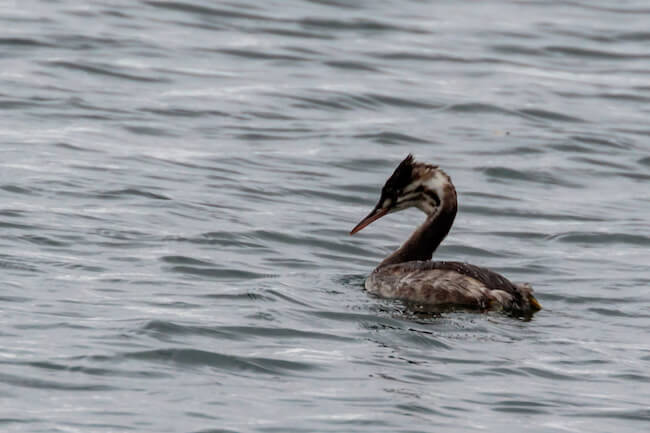 Juvenile still showing stripes on head
Juvenile still showing stripes on headMy Photography Gear
To complete the story I thought I would share details of the camera equipment I used to capture this story.
I was using a 400mm prime lens with a 1.4x extender on my Canon 7D Mark 2.
It goes to show that you don't necessarily need the latest and greatest camera or lens for wildlife photography. It's possible to pick up this older gear at a reasonable price second hand.
A tripod is a useful extra, to help keep the camera and lens stable.
Don't feel that you need the latest and greatest gear to undertake a similar project.
Capturing images to look back at is wonderful, of course, but the true joy lies in immersing yourself in the present moment, appreciating the beauty that surrounds you.
Enjoy the Beauty of Nature
As I reflect on my incredible journey with the Great Crested Grebes, I'm reminded that it's not about having the latest gear or dedicating hours a day to photography.
It's about taking small steps towards connecting with nature, and letting that connection inspire us to appreciate its beauty and complexity.
By slowing down and observing the world around us, we can discover the intricate wonders of species like the Great Crested Grebe, and develop a deeper appreciation for the natural world.
So, I encourage you to take just a few minutes each day to step outside, find a local spot to observe, and let the wonders of nature unfold before your eyes.
Trust me, the rewards will be well worth it.
Get closer to UK nature - Subscribe to Wild Lens!
I would love to send you my occasional newsletter so we can keep in touch.



